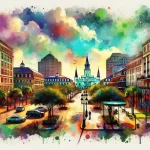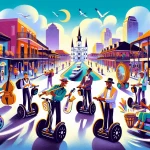New Orleans stands as the indisputable center of Mardi Gras festivities, a captivating and vibrant celebration that has mesmerized the world for centuries. At the core of this cultural phenomenon lie the city’s Mardi Gras museums, serving as repositories of history, tradition, and artistic expression. These institutions offer visitors a unique opportunity to immerse themselves in the rich heritage of Mardi Gras culture, from its origins to its modern-day manifestations.
In This Article
TL;DR
- Mardi Gras museums showcase the vibrant traditions and history surrounding this iconic New Orleans celebration.
- Exhibits feature intricate costumes, masks, floats, and artifacts, revealing the artistry and legacy of Mardi Gras.
- These museums provide immersive experiences, educational programs, and accessibility features to enhance visitor understanding.
The Historical Context of Mardi Gras in New Orleans
Mardi Gras, or “Fat Tuesday,” has its roots in the Christian tradition of indulging in revelry and feasting before the solemn period of Lent. However, in New Orleans, this celebration has evolved into a vibrant and multifaceted cultural phenomenon that transcends religious boundaries.
The city’s unique blend of French, Spanish, African, and Native American influences has shaped the Mardi Gras celebrations over the centuries, giving rise to a rich heritage of traditions, rituals, and artistic expressions. From the elaborate costumes and masks to the intricate float designs and the lively music and dance performances, Mardi Gras in New Orleans is a true celebration of diversity and creativity.
Key Mardi Gras Museums in New Orleans
Mardi Gras World
Mardi Gras World is a must-visit destination for anyone seeking to understand the behind-the-scenes magic of Mardi Gras. This massive warehouse, situated on the banks of the Mississippi River, is where the iconic floats are designed, constructed, and stored. Visitors can take guided tours and witness firsthand the intricate craftsmanship that goes into creating these larger-than-life masterpieces.
Address: 1380 Port of New Orleans Pl, New Orleans, LA 70130
Phone: (504) 361-7821
Hours: Monday-Saturday 9:30AM-5:30PM
The Presbytere
Housed in the historic Presbytere building, adjacent to the St. Louis Cathedral in the French Quarter, the Mardi Gras Museum offers a comprehensive look at the history and traditions of this iconic celebration. The museum’s exhibits showcase an impressive collection of costumes, masks, and artifacts from past Mardi Gras celebrations, providing visitors with a glimpse into the evolution of this cultural phenomenon.
Address: 751 Chartres St, New Orleans, LA 70116
Phone: (504) 568-6968
Hours: Tuesday-Sunday 10AM-4:30PM
The Backstreet Cultural Museum
Located in the historic Tremé neighborhood, the Backstreet Cultural Museum offers a unique perspective on the African American influence on Mardi Gras celebrations. This museum showcases the rich traditions of the Mardi Gras Indians, a vibrant subculture that emerged in the 19th century as a way for the African American community to celebrate their heritage and express their cultural identity.
Address: 1116 Henriette Delille St, New Orleans, LA 70116
Phone: (504) 522-4806
Hours: Monday-Saturday 10AM-5PM
Exhibits and Collections
The Mardi Gras museums in New Orleans boast a wealth of exhibits and collections that showcase the rich history and cultural significance of this iconic celebration. From elaborate costumes and masks to intricately designed floats and artifacts from past celebrations, these museums offer a comprehensive look at the evolution of Mardi Gras traditions.
One of the standout exhibits at the Presbytere is the “Carnival Bulletins” collection, which features a vast array of invitations, programs, and memorabilia from Mardi Gras balls and events dating back to the 19th century. Visitors can explore the intricate designs and themes of these bulletins, which offer a glimpse into the opulent and extravagant celebrations of the past.
At Mardi Gras World, visitors can marvel at the intricate craftsmanship that goes into creating the iconic floats that are the centerpieces of the Mardi Gras parades. From the towering structures to the vibrant colors and intricate details, these floats are true works of art. Visitors can also learn about the history and significance of the various Krewes (social clubs that organize Mardi Gras parades) and the unique themes and designs that they incorporate into their floats.
The Backstreet Cultural Museum offers a unique perspective on the African American influence on Mardi Gras celebrations, showcasing the rich traditions of the Mardi Gras Indians. Visitors can marvel at the intricate and colorful costumes worn by these groups, each one meticulously handcrafted with feathers, beads, and intricate designs that tell stories of cultural heritage and identity.
Educational Programs and Community Engagement
In addition to their impressive exhibits and collections, the Mardi Gras museums in New Orleans also play a vital role in educating the public and engaging with the local community. Many of these institutions offer a range of educational programs and initiatives designed to promote cultural understanding and appreciation.
At the Presbytere, visitors can participate in guided tours led by knowledgeable docents who provide in-depth insights into the history and traditions of Mardi Gras. These tours offer a unique opportunity to learn about the cultural significance of various elements, such as the symbolic colors of purple, green, and gold, and the importance of the King Cake tradition.
Mardi Gras World offers interactive workshops and demonstrations where visitors can learn about the intricate process of float construction and design. These hands-on experiences allow participants to gain a deeper appreciation for the skill and artistry involved in creating these larger-than-life masterpieces.
The Backstreet Cultural Museum actively engages with the local community through educational programs and cultural events that celebrate the rich heritage of the Mardi Gras Indians. These initiatives not only promote cultural preservation but also foster a sense of pride and identity within the African American community.
Visitor Experience and Accessibility
To ensure an optimal visitor experience, the Mardi Gras museums in New Orleans prioritize accessibility and convenience. Many of these institutions offer flexible hours and timed entry options to accommodate visitors’ schedules and preferences.
The Presbytere and Mardi Gras World both offer guided tours, which can be particularly beneficial for first-time visitors or those seeking a more immersive and educational experience. These tours are led by knowledgeable guides who can provide insights and context that enhance the overall understanding of the exhibits and collections.
Additionally, many of these museums have implemented accessibility features to ensure that visitors with disabilities can fully enjoy and appreciate the exhibits. This may include wheelchair-accessible entrances, audio guides, and other accommodations to cater to diverse needs.
Impact of Mardi Gras Museums on Local Culture and Tourism
The Mardi Gras museums in New Orleans play a crucial role in preserving and promoting the city’s rich cultural heritage, while also contributing to the local economy and tourism industry.
By showcasing the history and traditions of Mardi Gras, these museums help to educate both locals and visitors alike, fostering a deeper appreciation and understanding of this iconic celebration. This, in turn, helps to strengthen the cultural identity of New Orleans and reinforces the city’s reputation as a vibrant and unique destination.
Furthermore, the Mardi Gras museums serve as significant attractions for tourists, drawing visitors from around the world who are eager to experience and learn about this fascinating cultural phenomenon. This influx of tourism not only benefits the museums themselves but also supports local businesses, restaurants, and other attractions, contributing to the overall economic vitality of the city.
Future of Mardi Gras Museums
As the world continues to evolve, the Mardi Gras museums in New Orleans are also adapting and embracing new technologies and innovations to enhance the visitor experience.
Many of these institutions are exploring the use of augmented reality and virtual reality technologies to create immersive and interactive exhibits that transport visitors into the heart of Mardi Gras celebrations. These cutting-edge experiences not only captivate audiences but also provide a unique opportunity to engage with the cultural traditions in a more dynamic and engaging way.
Additionally, some museums are exploring the integration of digital archives and online exhibits, allowing visitors to access and explore collections and resources from anywhere in the world. This not only expands the reach and accessibility of these cultural treasures but also ensures their preservation for future generations.
As the Mardi Gras celebrations continue to evolve and adapt to changing times, the museums in New Orleans will undoubtedly play a vital role in documenting and preserving these cultural traditions, ensuring that the spirit of Mardi Gras remains alive and vibrant for generations to come.






